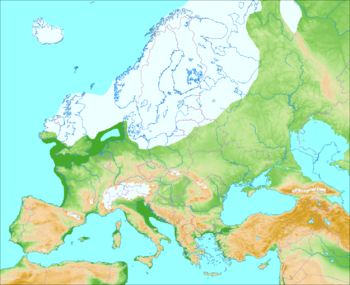
Back تجمد فايسلي Arabic Паазерскае зледзяненне Byelorussian Weichsel-istiden Danish Weichsel-Kaltzeit German Glaciación Weichseliense Spanish Weichseli jäätumine Estonian Veiksel-jääkausi Finnish Glaciation vistulienne French Glaciazione weichseliana Italian 바이흐젤 빙기 Korean

The Weichselian glaciation (Northern Polish glaciation) was the last glacial period and its associated glaciation in northern parts of Europe. In the Alpine region it corresponds to the Würm glaciation. It was characterized by a large ice sheet (the Fenno-Scandian ice sheet) that spread out from the Scandinavian Mountains[1] and extended as far as the east coast of Schleswig-Holstein, northern Poland and Northwest Russia. This glaciation is also known as the Weichselian ice age (German: Weichsel-Eiszeit), Vistulian glaciation, Weichsel[2] or, less commonly, the Weichsel glaciation, Weichselian cold period (Weichsel-Kaltzeit), Weichselian glacial (Weichsel-Glazial), Weichselian Stage or, rarely, the Weichselian complex (Weichsel-Komplex).
In Northern Europe it was the youngest of the glacials of the Pleistocene ice age. The preceding warm period in this region was the Eemian interglacial. The last cold period began about 115,000 years ago and ended 11,700 years ago.[3] Its end corresponds with the end of the Pleistocene epoch and the start of the Holocene. The German geologist Konrad Keilhack (1858–1944) named it using the German name (Weichsel) of the Vistula (Polish: Wisła) in present-day Poland.
| Evolution of the Baltic Sea |
|---|
| Pleistocene |
|
Eemian Sea (130,000–115,000 BC) Ice sheets and seas (115,000–12,600 BC) |
| Holocene |
|
Baltic Ice Lake (12,600–10,300 BC) Yoldia Sea (10,300–9,500 BC) Ancylus Lake (9,500–8,000 BC) Mastogloia Sea (8,000–7,500 BC) Littorina Sea (7,500–4,000 BC) Modern Baltic Sea (4,000 BC–present) |
© MMXXIII Rich X Search. We shall prevail. All rights reserved. Rich X Search